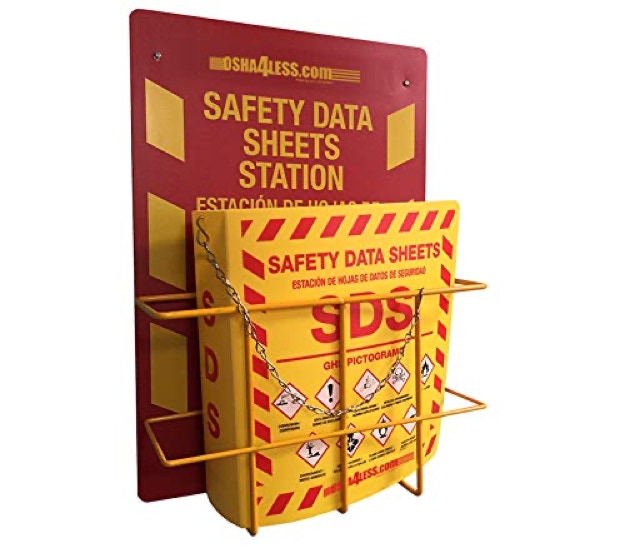Module 6:
Infection Control, Safety, First Aid, & Personal Wellness
Infections are a significant cause of illness, disease and death for residents that reside in certain living situations including nursing facilities. Residents of long-term care facilities are particularly at risk for infection due to the increased severity of illness experienced by residents being cared for in the facilities.
The resident is more at risk because of multiple underlying diseases, medications that reduce resistance to microorganisms, and use of medical devices such as urinary catheters to treat symptoms. Infection control is one of the most important aspects of providing a safe environment for residents. Nurse aides must understand and follow the facility’s infection control policies and procedures.
The goal of infection control is to develop and maintain an environment that minimizes the risk of acquiring or transmitting infectious agents to hospital personnel, patients, and visitors.
It is not always possible for you to know if a patient is infectious or is incubating an infection. Therefore, it is important that you understand how infections occur and follow infection control practices and policies to protect yourself and your patients from infectious agents.
Infection:
When a microorganism invades the body, multiplies, & causes injury or disease.
Infection control:
Infection control measures practice in healthcare facilities to prevent and control the spread of disease
Pathogens:
harmful microorganisms capable of causing infection or disease
Pathogens include:
Bacteria
Fungi
Protozoa
Viruses
Chain of Infection:
For an infection to develop, each link of a chain must be connected. Breaking any link of the chain can stop the transmission of infection
CHAIN OF INFECTION
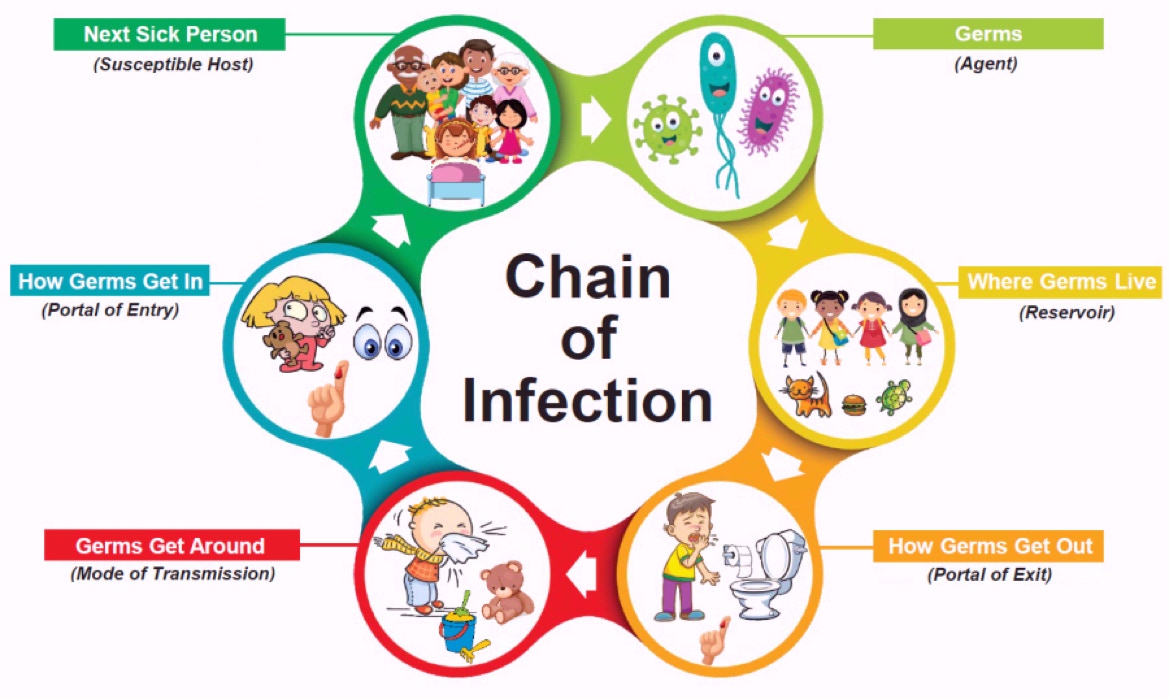
1. Infectious (causative) agent
- Pathogenic microbe responsible for causing an infection
2. Reservoir
- Source of infectious agent
-Place where microbe can survive & grow or multiply
- Includes: humans, animals, food, water, soil, equipment
3. Portal of exit
-A way an Infectious agent is able to leave a reservoir host
-Secretions & exudates, tissue specimens, blood, feces, urine
4. Mode of transmission
- Airborne
- Contact
-Direct (touching, kissing)
- Indirect (contaminated objects)
- Droplet (coughing, sneezing)
- Vector (insect, arthropod, animal)
- Vehicle (food, water, drugs)
5. Portal of Entry
- Way an infectious agent enters a susceptible host
-Includes: body orifices, mucous membranes, & breaks in skin
Mucous Membrane
The membranes that line body cavities, such as the mouth, nose, eyes, rectum and genitals
6. Susceptible host
- Someone with a decreased ability to resist Infection
- Factors: age, health, immune status
INFECTIONS
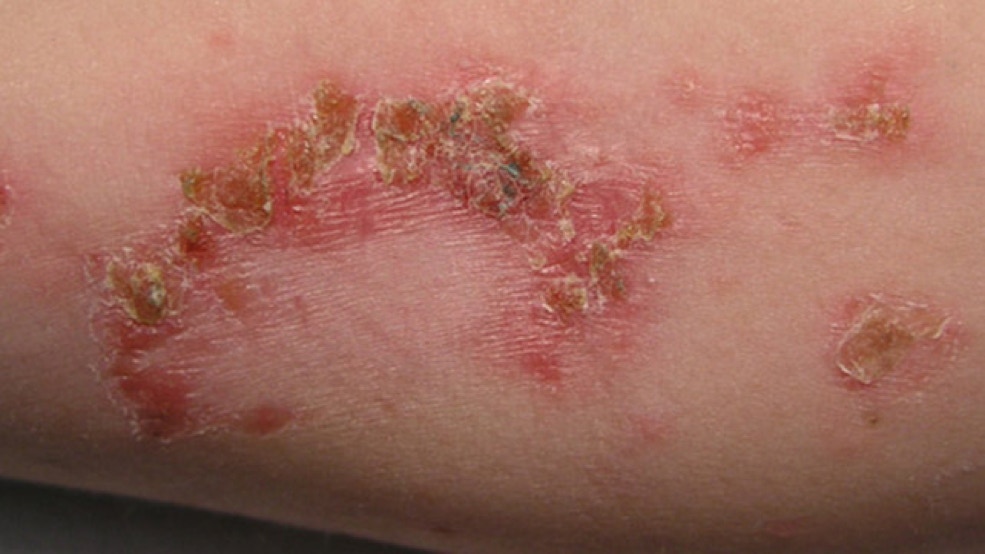
Types of Infections:
Localized infection:
an infection that is confined to a specific part of the body
Systemic infection:
an infection that is in the bloodstream and is spread throughout the body
Communicable:
Infections that are able to spread from person to person
Nosocomial or healthcare-associated Infections (HAIs)
infections that a patient has acquired within healthcare settings that result from treatment of other conditions, caused by infected personnel, patients, visitors, food, drugs, or equipment
GENERAL APPROACHES TO PREVENT AND CONTROL INFECTIONS

Medical asepsis (Clean Technique)
Practice(s) used to remove or destroy pathogens to prevent spread of infection from one person/place or object to another person/place or object.
Wash hands with soap and water. This is the single most important practice to prevent the transmission of infection.
Biohazard
Any material or substance that is harmful to health, also called infectious waste (such as blood, body fluids, and human cell lines).
This waste is contaminated with potentially infectious agents or other materials that are deemed a threat to public health or the environment.
It should always be identified by a biohazard symbol
Biohazard Exposure Routes
- Airborne
- Ingestion
- Non-intact skin
- Percutaneous (through the skin/needle stick)
- Permucosal (through mucous membranes/eyes)
PERSONAL PROTECTIVE EQUIPMENT
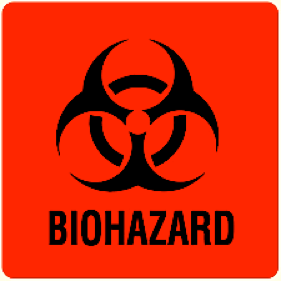
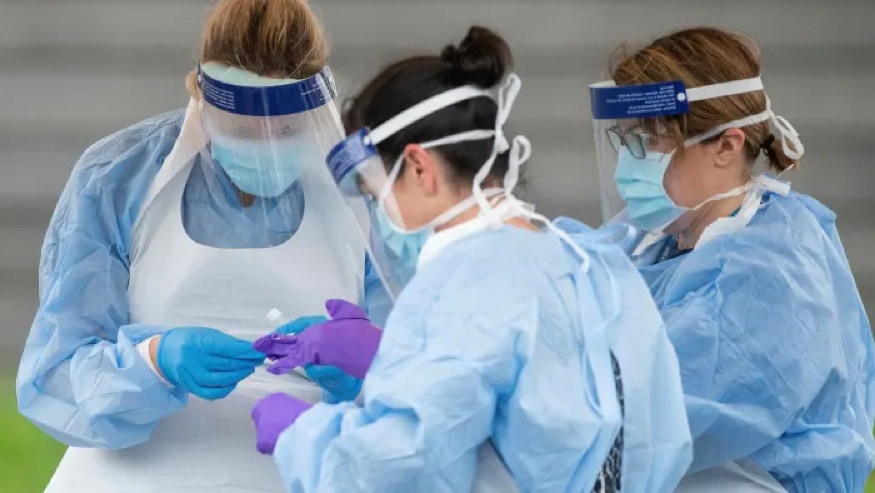
Personal protective equipment
• Gloves
• Gowns
• Lab coats
• Masks, face shields, & goggles
• Respirators
Universal precautions are a standard of always treating blood & body fluids of all people as they are potentially Infectious
Used for all patients and is the #1 strategy for control of nosocomial infections.
Covers blood, all body fluids, skin breaks, and mucous membranes
Isolation Procedures:
- Keep patients with communicable infections separate from others
- Prevent spread of Infection
- Protect patients with compromised immune system
- Isolation requires doctor's order
- Infected patient are confined to private room
- Transmission-based precautions
• Used for patients known/suspected to have certain infections
• Three types: 1. airborne, 2. droplet, 3. contact
AREA DECONTAMINATION

Cleanup of Body Fluid Spills
- EPA-approved chemical solutions & kits
- Gloves must be worn
- Absorb material without spreading it over wider area
Biohazard Waste Disposal
- All non-reusable items contaminated with blood or body fluids go in biohazard waste containers
Surface Decontamination (required by OSHA)
- All surfaces In specimen collection & processing areas
- 1:10 bleach solution or other disinfectant approved by Environmental Protection Agency (EPA).
BLOOD BORNE PATHOGENS
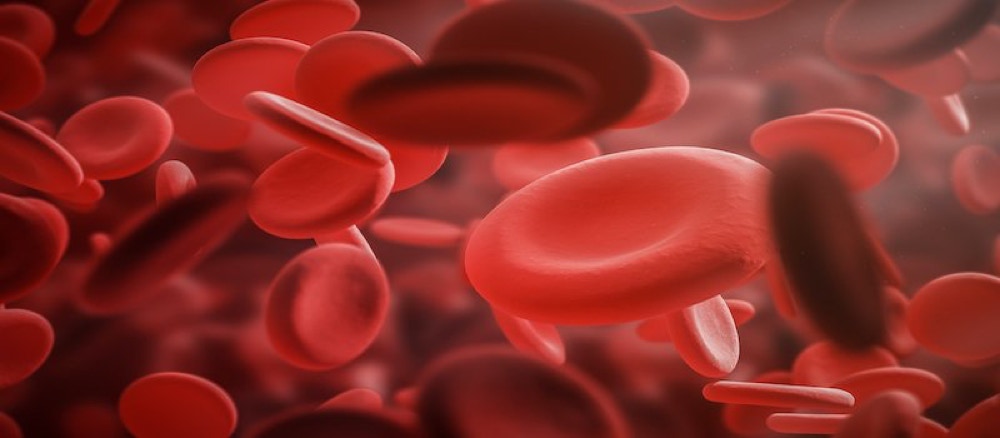
OSHA Standards for Blood-Borne Pathogens (BBPs)
- Enforced by federal law
-Intended to reduce/eliminate occupational exposure to BBPs
Requires:
• Availability & use of PPE
• Special training
• Availability of vaccination for all at-risk personnel
Blood-Borne Pathogen
- Hepatitis B virus (HBV)
• Best defense: HBV vaccination
• HBV exposure hazards
• Present in blood & other body fluids
• can survive up to a week on objects
• Transmitted via needle sticks, sexual contact
-Hepatitis C virus (HCV)
• HCV exposure hazards
• Present in blood & serum; sometimes saliva
• Infection primarily occurs after large or multiple exposures
• Transmitted via needle sticks, sexual contact
• BBP Exposure Routes
- Skin is pierced by a contaminated needle or sharp object
- Blood or other body fluid splashes In eyes, nose, or mouth
- Blood or other body fluid contacts cut, scratch, or abrasion
- A human bite breaks the skin
HIV/AIDS
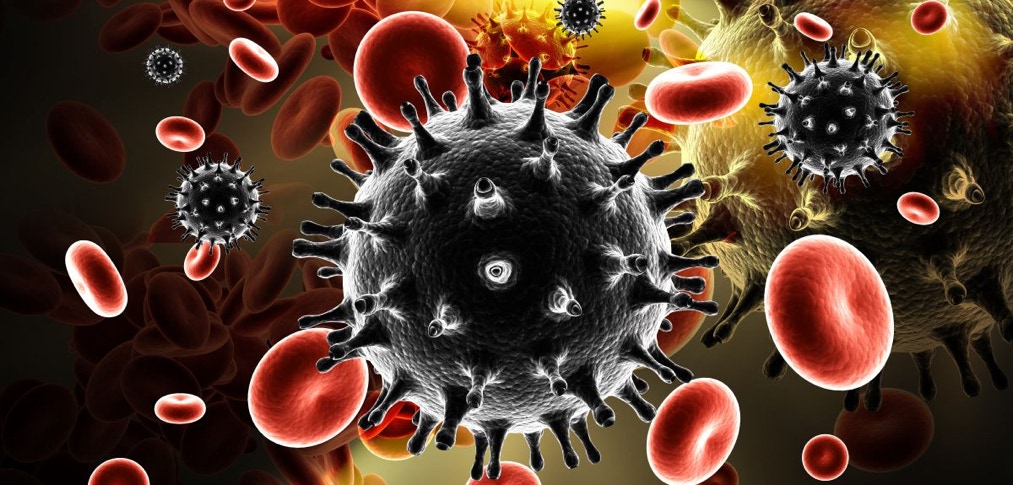
HIV attacks the immune system and disables it. It is transmitted by sexual contact, blood, infected needles, or from mother to fetus.
Acquired immunodeficiency syndrome (AIDS) is caused by human immunodeficiency virus (HIV)
Symptoms at transmission are like the flu.
Care guidelines for HIV / Aids:
If diarrhea is severe, doctor may order “BRAT” diet (bananas, rice apples, toast). This is helpful short-term.
Good rehydration fluids include water, juice, soda and broth. Avoid caffeinated beverages.
Numbness, tingling, and pain in the feet and legs is usually treated with medications.
Treat residents with respect and provide emotional support.
Provide safe environment and close supervision in ADL’s
Going barefoot or wearing loose, soft slippers may help. Bed cradle may be used.
Patient might requiere a bed cradle to avoid pressure ulcers to the tips of the toes.
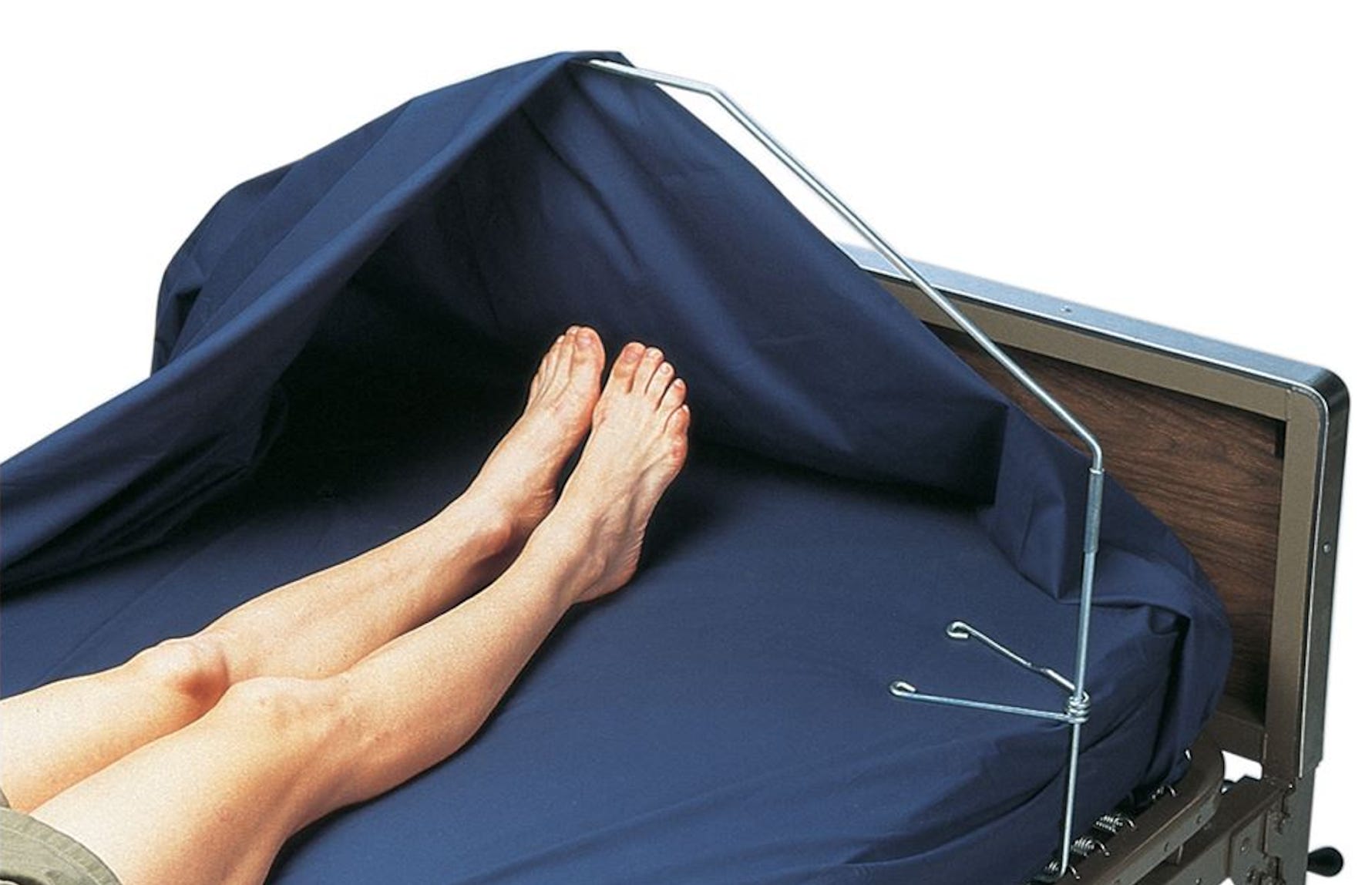
Safety data sheet: include information such as the properties of each chemical. protective measures; and safety precautions for handling, storing, and transporting the chemical.
Every Chemical used in your facility will have a MSDS in the MSDS Binder.
Every healthcare worker must know the location of the MSDS Binder in their facility in case of an emergency situation.
